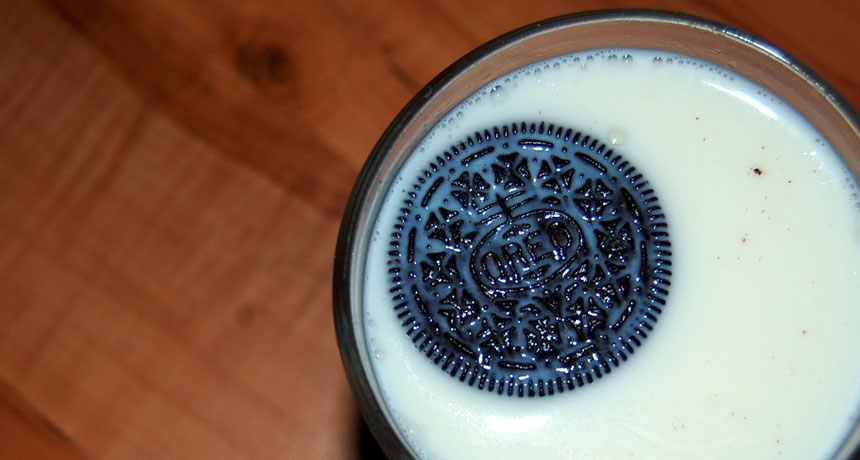Got milk? Do you know what’s in it?
A student tested his milk for antibiotics and a cancer causing toxin

Milk is a popular drink — with or without cookies. One teen wondered if there might be any dangerous chemicals in his favorite drink and used his science fair project to find out.
VSyogiTHEbear/Flickr/ (CC BY-NC-ND 2.0)
SAN JOSE, Calif.— Many people like milk. But Glenn Grimmett, 13, truly loves it. He downs around 1.9 liters (a half gallon) every day. So this teen at the Weiss School in Jupiter, Fla., was understandably upset when he learned that bad things sometimes taint that milk — such as dangerous chemicals from fungi and drugs used to kill bacteria. Then he designed a science fair project to probe for pollutants in his milk. And he found several.
Glenn showed off the results of his dairy investigation at an event known as Broadcom MASTERS (for Math, Applied Science, Technology and Engineering for Rising Stars). The competition brings together students with winning middle-school science-fair projects from across the United States. Finalists shared their work with each other and the public here on October 3. This annual science program was created by Society for Science & the Public. It’s sponsored by Broadcom, a company that builds devices to help computers connect to the Internet.
Cow’s milk contains many proteins and vitamins. But it also can include things such as added hormones and other chemicals fed to the cows. Such additives can help cows grow quickly and produce more milk. However, these chemicals can end up in the milk we drink. Milk also can pick up chemicals from a cow’s feed. Glenn was especially concerned about two of them — aflatoxin M1 and antibiotics.
Aflatoxin M1 is a toxin produced by the fungus Aspergillus. That fungus can grow on many crops, including both peanuts and the grain that’s fed to cows. The toxin is a known carcinogen, or substance that can cause cancer. In the United States, milk is tested for aflatoxin M1. It is illegal to sell milk containing this toxin at levels higher than 0.5 parts per billion — or one aflatoxin molecule per two billion molecules of milk.
Antibiotics are drugs used to kill germs. Many farmers give them to their cattle to help prevent disease. By keeping livestock healthy, antibiotics also can help animals grow faster. But the Food and Drug Administration places limits on the how much of these drugs can be present in milk sold in the United States.

ELISA tests come in kits, with all the solutions you need. Glenn got his by calling up Abraxis, a company that makes a type he wanted to use. “I contacted the CEO,” he says, which is the man who heads that company. “He allowed me to rent some of his equipment,” Glenn says. “He also let me rent ELISA test kits.”
Says Glenn, “I did my testing at home in my bathroom because it’s well ventilated.” For safety, the teen wore safety glasses, protective gloves and a lab coat. When he finished, “I returned all the chemicals to the company that gave it to me,” he notes.
He searched for aflatoxin M1 and two antibiotics — tetracycline (Teh-trah-SY-kleen) and sulfamethazine (SUL-fa-METH-uh-zeen).
Glenn found that 42 percent of his milk samples contained some aflatoxin. Amounts were quite low, below 0.5 parts per billion. The European Union has even tougher standards, permitting even less of the toxin. All but one milk sample met the European standard as well.
More concerning to Glenn, 14 of his 25 milk samples contained small amounts of sulfamethazine, and five contained tetracycline. Low amounts of antibiotics, over long periods of time, can lead to resistance— as bacteria evolve to fight off the drugs we use to kill them.
Most milk is tested for these drugs. Milk with more than 30 parts per billion of sulfamethazine or 300 parts per billion of tetracycline can’t be sold. Glenn would prefer that milk contain no antibiotics at all. His test is much more sensitive than the tests generally used, and could detect even trace amounts of the drugs. The teen argues that the milk industry needs a test that is more sensitive than it has now but is still quick, easy and reliable. “It needs to be able to test four million tankers each year,” he notes. Someday, Glenn hopes that routine milk tests will detect even trace levels of antibiotics and help to keep them out of his favorite drink.
Follow Eureka! Lab on Twitter
Power Words
(for more about Power Words, click here)
aflatoxin These are chemicals produced by the fungi belonging to the genus Aspergillus. They can cause cancer in humans and diseases in animals such as turkeys. Because they grow on grain and nut crops, they can get into food, including cow’s milk.
antibiotic A germ-killing substance prescribed as a medicine (or sometimes as a feed additive to promote the growth of livestock). It does not work against viruses.
antibody Any of a large number of proteins that the body produces as part of its immune response. Antibodies neutralize, tag or destroy viruses, bacteria and other foreign substances in the blood.
Aspergillus A genus of fungi which grows on grains, nuts and seeds. It produces a group of chemicals — called aflatoxins — which can cause cancer.
carcinogen A substance, compound or other agent (such as radiation) that causes cancer.
CEO An acronym for Chief Executive Office, which is typically the person who runs a company.
dairy Containing milk or having to do with milk. Or a building or company in which milk is prepared for distribution and sale.
ELISA (or enzyme-linked immunosorbent assay) This is a test used to detect very small amounts of chemicals in a liquid.
enzymes Molecules made by living things to speed up chemical reactions.
European Union The confederation of 28 European countries that have agreed to work peacefully together. Residents of EU can move freely between its member countries and sell goods to them. Most members have also adopted the same currency, known as the Euro.
Food and Drug Administration (or FDA) A part of the U.S. Department of Health and Human Services, FDA is charged with overseeing the safety of many products. For instance, it is responsible for making sure drugs are properly labeled, safe and effective; that cosmetics and food supplements are safe and properly labeled; and that tobacco products are regulated.
fungus (plural: fungi) One of a group of single- or multiple-celled organisms that reproduce via spores and feed on living or decaying organic matter. Examples include mold, yeasts and mushrooms.
hormone (in zoology and medicine) A chemical produced in a gland and then carried in the bloodstream to another part of the body. Hormones control many important body activities, such as growth. Hormones act by triggering or regulating chemical reactions in the body. (in botany) A chemical that serves as a signaling compound that tells cells of a plant when and how to develop, or when to grow old and die.
parts per million (billion or trillion) Frequently abbreviated as ppm (or ppb or ppt), it is a measure of the number of units of some material that it mixed into another. The units should be the same (or equivalent) for both materials. The term is used to describing extremely small concentrations of one chemical dissolved in another. For example, a solution of 300 parts per billion of sodium in water would mean that there are 300 sodium atoms for every billion water molecules.
proteins Compounds made from one or more long chains of amino acids. Proteins are an essential part of all living organisms. They form the basis of living cells, muscle and tissues; they also do the work inside of cells. The hemoglobin in blood and the antibodies that attempt to fight infections are among the better-known, stand-alone proteins.Medicines frequently work by latching onto proteins.
resistance (as in drug resistance) The reduction in the effectiveness of a drug to cure a disease, usually a microbial infection.
Society for Science and the Public (or SSP) A nonprofit organization created in 1921 and based in Washington, D.C. Since its founding, SSP has been not only promoting public engagement in scientific research but also the public understanding of science. It created and continues to run three renowned science competitions: The Intel Science Talent Search (begun in 1942), the Intel International Science and Engineering Fair (initially launched in 1950) and Broadcom MASTERS (created in 2010). SSP also publishes award-winning journalism: in Science News (launched in 1922) and Science News for Students (created in 2003). Those magazines also host a series of blogs (including Eureka! Lab).
solution A liquid in which one chemical has been dissolved into another.
standards (in research) The values or materials used as benchmarks against which other things can be compared. For instance, clocks attempt to match the official standard benchmark of time — the second, as calculated by the official atomic clock. Similarly, scientists look to identify a chemical by matching its properties against a known standard for a particular chemical. (in regulations) A limit above which something may not be used, sold or considered safe.
sulfamethazine A type of antibiotic, which is a chemical that can kill bacteria.
tetracycline A type of antibiotic, which is a chemical that can kill bacteria.
ventilation (v. ventilate) The movement of fresh air into a room or processes that move air around and between different rooms.
vitamin Any of a group of chemicals that are essential for normal growth and nutrition and are required in small quantities in the diet because they cannot be made by the body.







